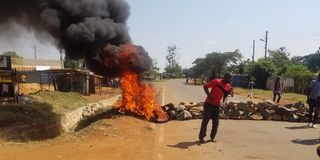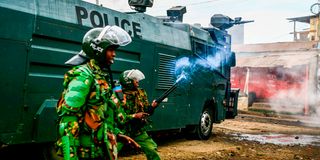Three police officers sat inside their Ford Ranger pick-up at the junction of Harambee Avenue and Kimathi Lane in the city a few minutes past 1pm on Wednesday, July 19, 2023. One was drinking milk and the other two taking yoghurt as they engaged in loud, animated banter. There were only three of them at the back of the pick-up, and under the benches lining either side of the truck were an assortment of anti-riot gear, including crates of tear gas, shields and batons.

Police water cannon trucks and more officers arrive to back up police engaged in running battles with protesters on Joseph Kang’ethe Road in Kibra, Nairobi, on July 19, 2023.
Photo credit: Billy Ogada | Nation Media Group
They were all in civilian clothes; with one going completely undercover by wearing those long blue aprons beloved of traders and cart pushers in the trading district of the city east of Moi Avenue. A uniformed driver and another police officer, also uniformed, sat at the front, their eyes trained on the usually busy junction of Moi and Kenyatta Avenues, the two roads named after the first and second presidents of the republic.

A protester pleads with police after being arrested by police along Joseph Kang’ethe Road in Kibra, Nairobi, on July 19, 2023.
Photo credit: Billy Ogada | Nation Media Group
This scene – of police officers armed to the teeth but sitting in their trucks, pick-ups, buses, vans and unmarked saloon cars at strategic sections – was repeated in various parts of the city. Their mission was simple, and it worked for the better part of the day: keep protesters from pouring into the streets by acting as the first responders and quickly calling for back-up should the situation escalate.
As a result, the city was practically cordoned off from protesters from early morning yesterday, who were kept at bay about five kilometres from the Central Business District on every main route leading to the city. That included heavy police presence on Thika Road just before the Survey area, another in the Mathare neighbourhood of Juja Road, another at the Adams Arcade junction that links the road to Woodley from Ngong Road, and another in Kangemi, just a few kilometres from the Westlands district on Waiyaki Way.
On Day 1 of a three-day protest marathon called by Azimio leader Raila Odinga to protest against the high cost of living, President William Ruto appeared to have had the upper power after deploying his instruments of State violence and flexing the fire power of the security services under his command.
The tension was palpable. Tangible, even. There might not have been a single teargas canister thrown in the CBD, but the city still retained that unmistakable, ominous calm before the storm. Walking down the main streets of the city gave one that edgy assurance that comes from the uniformed presence of police officers on patrol, but the apprehension was conspicuous, hanging in the air like a musky, pungent fragrance from the underworld.
All government offices and day primary and secondary schools remained closed throughout the day. In the Nyamakima sector of the city, where traders sell all manner of wares, especially from China, many shops remained open but the footfall from customers was painfully far and wide between. Compared to the CBD, however, the section of the city north of Moi Avenue retained a semblance of normalcy, under heavy police guard.

By 11am, protesters had block roads and lit fires in Siaya town.
Photo credit: Kassim Adinasi | Nation Media Group
At 11:48am, a lone man sat at the Kimathi Street branch of KFC having his meal. This restaurant, along with many others on what is perhaps one of the busiest streets in the Nairobi CBD, is usually packed with patrons all day. The Co-operative Bank banking hall on the street was empty too, as was the Safaricom Care shop next to it. About a kilometer away on University Way, virtually all businesses remained closed, as they did on Haile Sellassie Avenue, City Hall Way, Loita Street and Koinange Street.
And so, while President Ruto appeared to be on course to taming the violence on Day 1 of these protests, Mr Odinga seemed to have achieved his plan of disrupting economic activities and generally staging a quiet rebellion without even stepping out into the streets.
“This thing is now bigger than Raila,” a man said in the Mathare district, where Nation driver Immaculate Joseph had quickly reversed the car we had been using to patrol the city after we ran into an active riot, and to where I had insisted on returning on foot soon after we drove to safety.

A police officer fires a tear gas canister at protesters along Joseph Kang’ethe Road in Kibra, Nairobi, July 19, 2023.
Photo credit: Billy Ogada | Nation Media Group
By “this thing”, the man was referring to the string of Maandamano called by the Azimio leader in recent weeks, but which have been branded illegal by the police and other State agencies. The protests appeared to be taking a life of their own, fueled by growing dissent over the high cost of living, perceived police high-handedness, and the misery of hundreds of thousands of unemployed youth who have nothing to do, and therefore nothing to lose.
When the protests started at the start of the year, there would be muted protests in the city and parts of Mombasa and Kisumu, and these would erupt into total chaos soon after Mr Odinga emerged, often early in the afternoon, and, in the thick of teargas and police batons, attempted to make his way to Kamukunji of Jacaranda grounds in the city. In recent weeks, however, Mr Odinga has scarcely needed to make a public appearance for the protests to kick to full gear, but behind the scenes he has been running a robust propaganda machine that has called on millions of his supporters across the country to turn up for “peaceful protests”.

Anti-riot police officers on Raila Odinga Road in Lang’ata on July 12,2023 during the anti-government protests.
Photo credit: Evans Habil | Nation Media Group
The mostly young men who have been heeding his calls, and who refer to him as Baba, poured to the streets yesterday, engaging police in running battles in Woodley, the scene of deadly clashes last week in Mlolongo, in Kibera, Mathare and some pockets of Kawangware. Nation correspondents reported two deaths by 4pm last evening, one in Makueni and another in the Shabaab neighbourhood of Nakuru, but police were yet to confirm the fatalities by last evening.
Protests accompanied by various degrees of violence were reported in various parts of the country, including Mombasa, Kilifi, the Nyanza belt, Meru, Nakuru, Kisii, Machakos and parts of western Kenya.
In the Mathare sprawl of the city, rioting mobs blocked the road at a bend just a few metres from the entrance to the Moi Airbase. Heavily armed Air Force sentries guarded the gate, and across the road a group of about 10 undercover police officers kept watch. Every now and then a young man would attempt to break the cordon and run into the road, and every now and then the undercover officers would subdue him, arrest him and hand him over to their uniformed colleagues.

A Kenya Police Officer runs away from a group of opposition supporters chasing him and throwing stones during anti-government protests in Nairobi on July 19, 2023.
Photo credit: Luis Tato | AFP
The mobs on the other side would erupt in protest, throwing stone missiles and epithets at the police officers. The police would retaliate by charging at them and shooting teargas canisters into the crowds, then the chaos would calm down and the teargas dissipate into the air. A few minutes later, the same cycle would be repeated, over and over again.
In Muthaiga, the posh neighbourhood in the northerly suburbs of the city where former First Lady Mama Ngina Kenyatta owns a residential home, all was quiet and tranquil. At 11:15am a man was walking his dog on Serengeti Avenue while a gardener was watering flowers and an immaculate lawn of grass outside her master’s home on Tchui Lane. A few metres away, sentries from a private security firm guarded the home of Mama Ngina after the State withdrew the contingent of police officers detailed to her on Tuesday evening.
At 90 years, Mama Ngina finds herself thick in the middle of the political fight pitting Mr Odinga and President Ruto. Politicians allied to the President, and indeed a sitting Cabinet Secretary, have claimed, without providing any evidence, that a section of the Kenyatta family is funding Mr Odinga’s protests. In the past, mobs have invaded properties associated with the family on a looting and vandalising spree.

Police arrest suspected protesters in Homa Bay town on July 19, 2023.
Photo credit: George Odiwour | Nation Media Group
On Tuesday, a group claiming to be members of a traders’ union in Nairobi wrote to the police indicating they would be holding a “peaceful” protest at the city and Gatundu homes of the First Lady, and it is understood that this letter, coupled with the withdrawal of the police sentries at the gate, was viewed within the Azimio circles as a direct attack on Mama Ngina. Her son, former President Uhuru Kenyatta, supported Mr Odinga in the race for the presidency last year, and Dr Ruto’s camp has suggested that the former President and a section of his family is bankrolling the Azimio wave of protests. The Kenyatta family has not commented on those claims.
Azimio leaders yesterday protested at those security withdrawals, calling them politically motivated to intimidate and cow them. Reports indicated that Mr Odinga’s security detail has also been withdrawn from his Nairobi, Kisumu and Siaya residences. Several Azimio leaders, including governors Anyang’ Nyong’o (Kisumu), Ochillo Ayacko (Migori) and Gladys Wanga (Homa Bay) have also reported the withdrawal of their police security detail.
Last evening Azimio, through Mr Odinga’s running mate in the last elections, Ms Martha Karua, said in a media briefing that people it believed were police officers had detained a couple of its senior officials, including long-time Mr Odinga’s spokesman Dennis Onyango, whom it said had been abducted from his home in the morning. Also detained during Wednesday’s demonstrations were Kilifi South MP Ken Chonga and Mr Teddy Mwambire, the Speaker of the Kilifi County Assembly.
The Nation had not confirmed the whereabouts of the three by last evening, but Ms Karua, demanding “respect for our constitution and laws”, argued that “their continued unlawful detention, which the Ruto regime has sanctioned… is a flagrant violation of our Constitution and laws”.
As the sun set on an uneasy city and a blanket of darkness creeped in, the few people who had made their way into the city started leaving. As early as 5:30pm, the city was a virtual ghost town, devoid of the hustle and bustle that has defined it for decades.
There wasn’t the usual traffic helter-skelter of the usual Nairobi evening, of the bustle of a million people going home from a day’s labour, or the hubbub and boom-boom of entertainment joints playing music at the bone-conduction level. All was calm and quiet. A weary city was going to sleep after daylong tensions. Mr Odinga and his supporters had managed to shut down Nairobi, but Dr Ruto and his clever deployment of brute force had shut them down, too.

